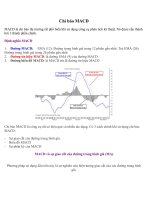Understanding MACD
Bạn đang xem bản rút gọn của tài liệu. Xem và tải ngay bản đầy đủ của tài liệu tại đây (3.28 MB, 58 trang )
Understanding
MACD
Gerald Appel
and
Edward Dobson
Traders Press, Inc.®
PO Box 6206
Greenville, SC 29606
Copyright© 2007 by Traders Press, Inc.
Reprinted January 2008
All rights reserved. Printed in the United States of America. No part of this publication may be reproduced, stored in a retrieval system or transmitted, in any form or by any means, electronic, mechanical,
photocopying, recording, or otherwise, without the prior written permission of the publisher.
ISBN 10: 0-934380-92-9
ISBN 13: 978-0-934380-92-8
This publication is designed to provide accurate and authoritative information with regard to the subject
matter covered. It is sold with the understanding that the publisher is not engaged in rendering legal,
accounting, or other professional advice. If legal advice or other expert assistance is required, the services of a competent professional person should be sought.
Published by
Traders Press, Inc.®
Traders Press, Inc.®
PO Box 6206
Greenville, SC 29606
800-927-8222 ~ 964-298-0222 ~ Fax 864-298-0221
Website
This booklet is dedicated to
Gerald Appel,
the creator of MACD
and the chief contributor to the material presented herein.
Gerald Appel
Publisher’s Foreword
I first learned about MACD (Moving Average ConvergenceDivergence) in the early 1980’s, shortly after Gerald Appel
published his groundbreaking research report which “revealed”
this new technical indicator. In 1986, he updated and expanded his
original report, and shared with the reader how he used and
interpreted it in his own market analysis. This updated report,
reproduced in its entirety, is the heart of this work, which is intended
to give the reader a basic understanding and knowledge of MACD
and how to use it effectively in market analysis and timing. It is my
belief that the most effective way to achieve this goal is to hear it
straight from the “master” on the subject.
The idea for this book came about years ago one night when
my old friend Gerald and I were having dinner with our mutual
friend Alex Elder in Chicago. It has been a long time in the making
since then. Originally, Gerald felt that the original manuscript and
charts would need to be updated with current examples and
commentary. He didn’t even have a copy of the report, which had
gone out of print and was no longer available. After a diligent search
I was able to locate an old used copy, which was forwarded to him
to be updated and revised. Surprisingly, after looking it over closely
(this being some 20 years after it was written), he advised that he
felt it was “OK” as it was, and needed no updating. I feel that this
attests to the fact that markets, over time, no not really “change”,
and some indicators and principles stand the “test of time” and are
just as valid today as they were decades ago. In terms familiar to
systems developers, they are “robust”.
My special thanks to Shelley Mitchell, whose painstaking
research and diligent effort produced the listing of articles and
annotated bibliography which add a valuable dimension to this
work.
It is my hope that this reprinted material, along with
the annotated bibliography of articles and references and
a few brief comments of my own, will prove helpful to you
in your pursuit of trading excellence.
Edward D. Dobson, President
Traders Press, Inc.
Greenville SC
Introduction
There has long been a need for this booklet. MACD (Moving Average
Convergence-Divergence has long been one of the most popular and
widely available technical indicators since it was developed by Gerald
Appel in the late 1970’s. However, since Appel’s last published research
on the subject, published in 1986, went of out print and was no longer
available, there has been no work solely dedicated to this topic. There
are a number of excellent books which contain discussion and
explanation of MACD, but only in passing and not in depth. Research
of all past literature dealing with MACD shows that Appel’s own indepth work on the subject is the best resource for learning and mastering
the use of this indicator….thus, this work is reprinted herein in its entirety.
As explained in the Foreword, though this material is over twenty years
old, it is still as relevant and applicable today as when it was originally
written.
Those interested in furthering their knowledge of MACD are encouraged
to take special note of the articles listed herein, and of the references in
other works in the bibliography. The most notable of these works is
Appel’s own “Technical Analysis: Power Tools for Investors”, which
has a major section and treatment of MACD, and which was recently
published in 2005. This book is a valuable reference and resource for
serious traders and investors.
Of all the many technical indicators and studies available today in
technical analysis software, it is my belief that MACD is one of the
most helpful and reliable. An old acquaintance of mine, who spent
literally thousands of hours over a period of years studying various
technical indicators, eventually came to the conclusion that the only
two indicators truly worth using were ADX and MACD, applied over
multiple time frames simultaneously.
The MACD histogram, which shows the difference between the two
MACD lines, was preferred over the two lines themselves. When this
histogram crosses the zero line in either direction, it shows a crossing of
the two lines. When the histogram reading peaks and turns up or down,
indicating that the differential between the lines has run out of momentum
and begun to decrease, is an early signal that occurs well before an
actual crossing of the lines. My acquaintance used this occurrence as
one of the main components of a trading methodology (coupled with
ADX readings). I first became aware of the use of the MACD histogram
in the late 1980’s, when my friend Alex Elder used and discussed it
extensively in a market letter he published at that time. Another reference
I highly recommend for discussion of MACD and the Histogram is the
relevant section in Elder’s classic “Trading for a Living”, one of the
best and most helpful trading books ever written, in my opinion.
Key Points
MACD (Moving Average Convergence-Divergence) is a technical
indicator which is a featured indicator in virtually every computer
based technical analysis software, trading program, and trading
platform. Strangely, despite its overwhelming popularity, there has
been relatively little written about it or the best ways in which it can
be used. This work is intended to fill that void.
This section will give an overview of MACD by listing a number of
key points which will give a basic understanding of the indicator. The
section from Gerald Appel’s original research report which follows
gives copious illustrations of how to use and interpret MACD.
MACD is a trend following momentum indicator
MACD is generally considered to be one of the most effective
indicators for defining trend
MACD consists of three exponential moving averages
An exponential moving average gives more weight to the latest
data and less to the oldest data
The most common exponential moving averages used to
calculate MACD are 9, 12, and 26 periods. These are usually the
default settings in most technical analysis software
Shorter term moving averages respond to changes in prices
more quickly, longer term averages more slowly
The MACD indicator consists of two lines: the MACD line and
the Signal line.
The MACD line is the difference between a 12 and a 26 period
EMA of prices and is plotted as a solid line.
The Signal line is a 9 period EMA of the MACD line.
Moving averages other than the standard 9, 12, and 26 may be
used. Some traders try to optimize MACD by using other EMA
combinations
Few traders make these calculations by hand. A computer does
the job much more quickly and accurately. The reader is urged to
obtain and use technical analysis software for this job if not already
employed.
There are three methods commonly used to interpret MACD:
1. Buy and sell signals are given when the MACD line crosses
above or below the slower Signal line
2.Divergence: when prices diverge from the MACD it often
signals the end of a trend
3.Sharp rise or fall in the MACD Line. When the difference
between the MACD and the signal lines goes to an extreme and
then changes direction prices are viewed as overbought or
oversold
The difference between MACD and the Signal line is often
graphically depicted as an MACD-Histogram. It measures the spread
between the two lines.
Gerald Appel/Edward Dobson
The slope of the MACD histogram and changes in its direction
can be helpful in spotting turning points.
A reference that is very helpful in understanding how to use the
Histogram and other trading rules is Elder’s “Trading for a Living”,
pages 127-135. This is highly recommended reading.
MACD analysis may be applied to any active security,
commodity, or index
In like manner, it may be used in virtually any time frame, from
very short (minutes) to very long (monthly)
Short term traders and long term investors alike will find this
indicator useful
The best signals are given when short term analysis coincides
with longer term analysis, thus putting the trader “in sync” with the
major long term trend
The reader is urged to closely study price charts with
corresponding MACD studies to observe first hand how the studies
correlate to price movements before actually trading signals
generated by MACD
Like many useful technical analysis techniques, there is no
claim made for the statistical validity of MACD, just the empirical
observation that IT WORKS
10
Understanding MACD
Moving Average Convergence-Divergence
Gerald Appel
11
Gerald Appel/Edward Dobson
CHART 1
THE BASIC STRUCTURE OF MACD
A shorter term moving average will rise more quickly than a longer term moving average during market uptrends. As the rise comes to an end, the slower moving average
will catch up, narrowing the distance between them. This narrowing suggests an end to
the advance. The same pattern occurs during market downtrends. The differential
between the two moving averages may be plotted as a histogram.
12
Understanding MACD
CHART 2
INTRODUCING THE SIGNAL LINE
The differential between the two moving averages may also be plotted as a line, which
will correspond to the high and low extremes of the histogram. A moving average is
then created of the differential between the two moving averages that comprise MACD.
We usually plot this moving average as a dotted line and refer to it as the signal line.
The moving average signal line is usually between 5-10 days in length and serves to
define the trend of the differential. When the differential lies above its moving average,
MACD is in a positive mode. When the differential lies below its moving average, the
trend of MACD is considered negative.
13
Gerald Appel/Edward Dobson
CHART 3
THE BASIC BUY AND SELL SIGNALS
As a basic, buy signals are generated in MACD when the MACD line (the line that
measures the differential between two moving averages) crosses from below to above
its signal line. Sell signals are generated when the MACD line crosses from above to
below its signal line. More advanced buy and sell signals will be illustrated on the
following pages.
14
Understanding MACD
CHART 4
USING DIVERGENCES TO RECOGNIZE THE MOST RELIABLE SIGNALS
Divergences between price patterns and momentum patterns often serve to identify
the most profitable buy and sell signals. A positive divergence exists when prices fall to
a new low, but MACD fails to make a new low along with declining price movement.
This divergence indicates decreasing downside momentum. A fine example is shown
on the above chart between points 3 - 4. The buy signal that took place at 4 was likely
to prove more reliable than the buy at 3 because of the positive divergence that preceded the buy.
Negative divergences exist when prices move to new highs but MACD fails to make
a new peak along with price. Such patterns appear on the chart between Areas 1 - 2
and at Area 5. The sell signal at Point 2 was more likely to prove significant than the
sell at Point 1 because of the negative divergence that preceded the sell in that area.
15
Gerald Appel/Edward Dobson
CHART 5
FURTHER EXAMPLES OF DIVERGENCES
A positive divergence developed between Points 6 - 7, price formations showing
equal lows while MACD traced out a rising formation. The sell at Point 9 was likely to
prove more significant than the sell at Point 8 because of the negative divergence that
preceded the sell signal.
16
Understanding MACD
CHART 6
COMPARING MACD TO A PRICE MOMENTUM OSCILLATOR
MACD is a very smooth timing oscillator compared to daily momentum oscillator
indicators. Its buy signals (July and December on the chart) are clearer as are its sell
signals.
There was, incidentally, no buy signal in October even though MACD crossed from
below to above its signal line. As a general rule, MACD must first fall below 0 as a
precondition for a buy signal. MACD must rise above 0 once a buy signal is generated
before a sell signal can be generated, unless the indicator falls to a new low, which then
generates a sell below the 0 line.
17
Gerald Appel/Edward Dobson
CHART 7
COMPARING MACD TO THE RELATIVE STRENGTH INDEX
RSI is an excellent technical tool with many applications. However, we see on this
chart again that MACD provides much smoother lines, leading possibly to easier
interpretation.
Both MACD and RSI generated fine positive divergences in February as both tools
provided valid buy signals simultaneously.
18
Understanding MACD
CHART 8
COMBINING TWO MACD COMBINATIONS WITH TREND FOLLOWING
TECHNIQUES FOR MORE ACCURATE SIGNALS
Since most markets tend to decline more rapidly than they rise, it is advisable to
employ a more rapid MACD combination (shorter term moving average pairings) to
track declining markets for buy signals and slower MACD pairings to track rising
markets for sell signals. Otherwise, buy signals tend to occur late and sell signals tend
to occur prematurely. In the above chart, we employ a 13-day, 26-day exponential
average pairing to generate buy signals and a 19-day, 39-day pairing to generate sell
signals.
A 50-day moving average is employed to define trend. If the average is rising sharply,
indicating a strong uptrend, we would employ an even more rapid MACD pairing (6day, 19-day) to generate buy signals and we might delay selling until negative divergences appeared, even if the signal line for the sell MACD is violated.
Trends in the above chart are, for the most part, neutral. Therefore, we do not employ
a very rapid MACD combination for buying and we sell immediately upon violation of
the signal line by the MACD line.
19
Gerald Appel/Edward Dobson
CHART 9
MACD DURING A STRONGLY UPTRENDED MARKET PERIOD
The stock market was in a general uptrend, the 50-day moving average flat to rising
for the most part, so we employed a rapid (6-day, 19-day) MACD for buying, keeping the 19-day, 39-day MACD as our sell trigger.
Once you buy on the shorter MACD pairing, you hold until the longer MACD pairing
(our sell trigger) rises to above 0, holding until that MACD line falls below its signal
line. You are stopped out prior to this only if the short term MACD falls below the
lowest level that immediately preceded its buy signal.
Buy conditions on the above chart were met when the 6-day, 19-day MACD line first
fell below 0 and then rose through its signal line. Signals took place during December
1984 and March 1985. The sell signal (based upon the 19-day, 39-day MACD lines)
in February was well timed.
The moving average was rising sharply at the time of the sell signal. In this case, we
might have bypassed the sell if not for the negative divergence traced out by the shorter
term MACD during the period preceding the sell.
20
Understanding MACD
CHART 10
MACD DURING A STRONGLY DOWNTRENDED MARKET PERIOD
The December 1987 US Dollar was in a very strong downtrend during the fourth
quarter of 1987. You can see the pattern of lower prices, confirmed by a rapidly
declining 50-day moving average.
In this situation, it is advised to sell rapidly when sell signals develop. On the chart
above, you may have well taken the sell signal indicated by MACD lines crossing from
above to below their signal lines even though the 19-day, 39-day MACD combination
did not stand in positive territory, unable to rise above 0 following the buy signal in
September.
Long side trades were not particularly profitable during the period shown. Short sales,
however, did prove quite profitable because of the market declines that immediately
followed sell signals.
21
Gerald Appel/Edward Dobson
CHART 11
TREASURY BONDS, MACD, AND A STRONG UPTREND
A fine buy signal was generated during August of 1989 by the 6-day, 19-day MACD.
The 19-day, 39-day MACD violated its signal line in September and investors might
have taken profits at that time. You would not have sold short, however. The 50-day
moving average was rising and even accelerating in its rise. No negative divergences
existed.
Given the strength of the advance, intermediate term investors might have given the
situation the benefit of the doubt, holding positions until a second sell signal was generated in October. By that time, clear negative divergences were being generated by
the 6-day, 19-day MACD. There were, however, no divergences in the 19-day, 39day MACD and the trend remained strongly up.
22
Understanding MACD
CHART 12
THE STOP LOSS SIGNAL FOR AN UNSUCCESSFUL TRADE
MACD generated a buy signal at A, the 6-day, 19-day MACD crossing its signal line
while the 50-day moving average was still rising.
However, the stock market turned down quickly and at Point B, the 6-day, 19-day
MACD declined to a low below the low level that preceded the buy signal at A. This
generated a stop loss sell signal. A loss on the trade had to be taken.
A new buy signal was generated several days later (not marked on the chart) and that
buy signal did turn out to be quite profitable.
23
Gerald Appel/Edward Dobson
CHART 13
USING TRENDLINES TO CONFIRM BUY AND SELL SIGNALS
The September 1989 Standard & Poor’s (S&P) contract was in a very strong uptrend
during the period shown on the chart.
Although we would not normally employ a long term MACD combination (the 19day, 39-day) as a buying trigger during such a climate, you can see how the use of
trendlines provided fine buy-sell confirmations of MACD - signal line crossings during
this period.
During strongly uptrended market periods, where no negative divergences exist, you
can usually bypass the first sell signals following very successful buy signals. Sometimes, you can even bypass the second sell signal, but as a general rule the second of
a series of sell signals should be followed.
24









